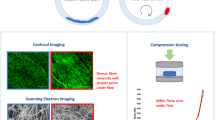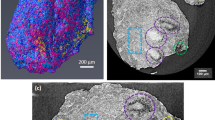Abstract
Sickle cell disease is a single point mutation disease that is known to alter the coagulation system, leading to hypercoagulable plasma conditions. These hypercoagulable conditions can lead to complications in the vasculature, caused by fibrin clots that form undesirably. There is a need to understand the morphology and structure of fibrin clots from patients with sickle cell disease, as this could lead to further discovery of treatments and life-saving therapies. In this work, a computational imaging analysis method is presented to evaluate fibrin agglomeration in the presence of erythrocytes (RBCs) homozygous for the sickle cell mutation (SS). Numerical algorithms were used to determine agglomeration of fibrin fibers within a matrix with SS RBCs to test the hypothesis that fibrin matrices with the inclusion of SS RBCs possess a more agglomerated structure than native fibrin matrices with AA RBCs. The numerical results showed that fibrin structures with SS RBCs displayed an overall higher degree of agglomeration as compared to native fibrin structures. The computational algorithm was also used to evaluate fibrin fiber overlap (aggregation) and anisotropy (orientation) in normal fibrin matrices compared to fibrin matrices polymerized around SS RBCs; however, there was no statistical difference. Ultrasound measurements of stiffness revealed rigid RBCs in the case of samples derived from homozygous SS blood, and densely evolving matrices, when compared to normal fibrin with the inclusion of AA RBCs. An agglomeration model is suggested to quantify the fibrin aggregation/clustering near RBCs for both normal fibrin matrices and for the altered structures. The results of this work are important in the sense that the understanding of aggregation and morphology in fibrin clots with incorporation of RBCs from persons living with sickle cell anemia may elucidate the complexities of comorbidities and other disease complications.








Similar content being viewed by others
References
Doolittle RF (1984) Fibrinogen and fibrin. Annu Rev Biochem 53(1):195–229
Brown AEX et al (2009) Multiscale mechanics of fibrin polymer: gel stretching with protein unfolding and loss of water. Science 325(5941):741–744
Brown AC, Barker TH (2014) Fibrin-based biomaterials: modulation of macroscopic properties through rational design at the molecular level. Acta Biomater 10(4):1502–1514
Baradet TC, Haselgrove JC, Weisel JW (1995) Three-dimensional reconstruction of fibrin clot networks from stereoscopic intermediate voltage electron microscope images and analysis of branching. Biophys J 68(4):1551–1560
Bidault L et al (2015) Fibrin-based interpenetrating polymer network biomaterials with tunable biodegradability. Polymer 62(0):19–27
Blombäck B et al (1989) Native fibrin gel networks observed by 3D microscopy, permeation and turbidity. Biochimica et Biophysica Acta (BBA) 997(1–2):96–110
Curtis DJ et al (2013) A study of microstructural templating in fibrin-thrombin gel networks by spectral and viscoelastic analysis. Soft Matter 9(19):4883–4889
Hantgan RR, Hermans J (1979) Assembly of fibrin. A light scattering study. J Biol Chem 254(22):11272–11281
Hartmann A, Boukamp P, Friedl P (2006) Confocal reflection imaging of 3D fibrin polymers. Blood Cells Mol Dis 36(2):191–193
Kim E et al (2011) Correlation between fibrin network structure and mechanical properties: an experimental and computational analysis. Soft Matter 7(10):4983–4992
Lai VK et al (2012) Microstructural and mechanical differences between digested collagen–fibrin co-gels and pure collagen and fibrin gels. Acta Biomater 8(11):4031–4042
Lesman A et al (2011) Engineering vessel-like networks within multicellular fibrin-based constructs. Biomaterials 32(31):7856–7869
Magatti D et al (2013) Modeling of fibrin gels based on confocal microscopy and light-scattering data. Biophys J 104(5):1151–1159
Mickel W et al (2008) Robust pore size analysis of filamentous networks from three-dimensional confocal microscopy. Biophys J 95(12):6072–6080
Molteni M et al (2013) Fast two-dimensional bubble analysis of biopolymer filamentous networks pore size from confocal microscopy thin data stacks. Biophys J 104(5):1160–1169
Rowe SL, Lee S, Stegemann JP (2007) Influence of thrombin concentration on the mechanical and morphological properties of cell-seeded fibrin hydrogels. Acta Biomater 3(1):59–67
Soon ASC et al (2010) Engineering fibrin matrices: the engagement of polymerization pockets through fibrin knob technology for the delivery and retention of therapeutic proteins. Biomaterials 31(7):1944–1954
Weisel JW (2004) The mechanical properties of fibrin for basic scientists and clinicians. Biophys Chem 112(2–3):267–276
Weisel JW (2005) Fibrinogen and fibrin. In: David ADP, John MS (eds) Advances in protein chemistry. Academic Press, Cambridge pp 247–299
Whittaker P, Przyklenk K (2009) Fibrin architecture in clots: a quantitative polarized light microscopy analysis. Blood Cells Mol Dis 42(1):51–56
Ye Q et al (2000) Fibrin gel as a three dimensional matrix in cardiovascular tissue engineering. Eur J Cardiothorac Surg 17(5):587–591
Chow E et al (2014) Effect of hypoglycaemia on thrombosis and inflammation in patients with type 2 diabetes. Lancet 383:S35
Dhall DP, Nair CH (1994) Effects of gliclazide on fibrin network. J Diabetes Complicat 8(4):231–234
Jörneskog G, Fatah K, Blombäck M (1998) Fibrin gel structure in diabetic patients before and during treatment with acetylsalicylic acid: a pilot study. Fibrinolysis Proteolysis 12(6):360–365
Mirshahi M et al (1987) Glycosylation of human fibrinogen and fibrin in vitro its consequences on the properties of fibrin(ogen). Thromb Res 48(3):279–289
Murakami T et al (1990) Increased accumulation of nonenzymatically glycated fibrinogen in the renal cortex in rats. Thromb Res 58(1):23–33
Nair CH et al (1991) Studies on fibrin network structure in human plasma. Part II—clinical application: diabetes and antidiabetic drugs. Thromb Res 64(4):477–485
Svensson J et al (2012) Acetylation and glycation of fibrinogen in vitro occur at specific lysine residues in a concentration dependent manner: a mass spectrometric and isotope labeling study. Biochem Biophys Res Commun 421(2):335–342
Tehrani S et al (2013) OC-04 Gender aspects of fibrin clot structure in patients with type 1 diabetes mellitus. Thromb Res 131:S72
Viswanathan GN et al (2014) Differences in thrombus structure and kinetics in patients with type 2 diabetes mellitus after non ST elevation acute coronary syndrome. Thromb Res 133(5):880–885
Walus-Miarka M et al (2012) Altered fibrin-clot properties are associated with retinopathy in type 2 diabetes mellitus. Diabetes Metab 38(5):462–465
Kwasny-Krochin B, Gluszko P, Undas A (2010) Unfavorably altered fibrin clot properties in patients with active rheumatoid arthritis. Thromb Res 126(1):e11–e16
Ballard HS (1978) Hemostatic alterations in sickle cell anemia. In: Caughey WS (ed) Biochemical and clinical aspects of hemoglobin abnormalities. Academic Press, Cambridge pp 67–76
Mann JR et al (1972) Ancrod in sickle-cell crisis. Lancet 299(7757):934–937
Stuart MJ, Setty BNY(2001) Hemostatic alterations in sickle cell disease: relationships to disease pathophysiology. Pediatr Pathol Mol Med 20(1):27–46
Keegan PM, Surapaneni S, Platt MO (2012) Sickle cell disease activates peripheral blood mononuclear cells to induce cathepsins K and V activity in endothelial cells. Anemia 2012:7
Platt MO, Shockey WA (2016) Endothelial cells and cathepsins: biochemical and biomechanical regulation. Biochimie 122:314–323
Ataga KI, Orringer EP (2003) Hypercoagulability in sickle cell disease: a curious paradox. Am J Med 115(9):721–728
Noubouossie DCF et al (2012) Evaluation of the procoagulant activity of endogenous phospholipids in the platelet-free plasma of children with sickle cell disease using functional assays. Thromb Res 130(2):259–264
Pakbaz Z, Wun T (2014) Role of the hemostatic system on sickle cell disease pathophysiology and potential therapeutics. Hematol Oncol Clin North Am 28(2):355–374
Colella MP et al (2015) Elevated hypercoagulability markers in hemoglobin SC disease. Haematologica 100(4):466–471
Noubouossie D, Key NS, Ataga KI (2016) Coagulation abnormalities of sickle cell disease: relationship with clinical outcomes and the effect of disease modifying therapies. Blood Rev 30(4):245–256
Ovbiagele B, Adams RJ (2012) Trends in comorbid sickle cell disease among stroke patients. J Neurol Sci 313(1–2):86–91
Gemmete JJ et al (2013) Arterial ischemic stroke in children. Neuroimaging Clin N Am 23(4):781–798
Menaa F (2013) Stroke in sickle cell anemia patients: a need for multidisciplinary approaches. Atherosclerosis 229(2):496–503
Marano M et al (2014) Recurrent large volume silent strokes in sickle cell disease. J Stroke Cerebrovasc Dis 23(10):e453–e455
Fan NK, Keegan PM, Platt MO, Averett RD (2015) Experimental and imaging techniques for examining fibrin clot structures in normal and diseased states. J Vis Exp 98:e52019
Shung KK (1982) Acoustic measurement of erythrocyte compressibility. J Acoust Soc Am 72(5):1364
Dahl JJ (2015) Diagnostic ultrasound: imaging and blood flow measurements (second edition). Ultrasound Med Biol. 41(12):3259–3260
Dong C, Chadwick RS, Schechter AN (1992) Influence of sickle hemoglobin polymerization and membrane properties on deformability of sickle erythrocytes in the microcirculation. Biophys J 63(3):774–783
Maciaszek JL, Lykotrafitis G (2011) Sickle cell trait human erythrocytes are significantly stiffer than normal. J Biomech 44(4):657–661
Vu-Bac N et al (2015) Uncertainty quantification for multiscale modeling of polymer nanocomposites with correlated parameters. Comp Part B Eng 68:446–464
Acknowledgments
Research reported in this publication was supported by the National Heart, Lung, and Blood Institute of the National Institutes of Health under Award Number 1K01HL115486 and by New Innovator Grant 1DP2OD007433 from the Office of the Director, National Institutes of Health. The content is solely the responsibility of the authors and does not necessarily represent the official views of the National Institutes of Health.
Author information
Authors and Affiliations
Corresponding author
Rights and permissions
About this article
Cite this article
Averett, R.D., Norton, D.G., Fan, N.K. et al. Computational imaging analysis of fibrin matrices with the inclusion of erythrocytes from homozygous SS blood reveals agglomerated and amorphous structures. J Thromb Thrombolysis 43, 43–51 (2017). https://doi.org/10.1007/s11239-016-1426-4
Published:
Issue Date:
DOI: https://doi.org/10.1007/s11239-016-1426-4




